Rebecca Ashton asks: What do you do when you’ve got a piece of exercise equipment that you think is amazing? You test it out on one of the most successful riders in the world!
Rebecca wrote the story and took the exercise photos…
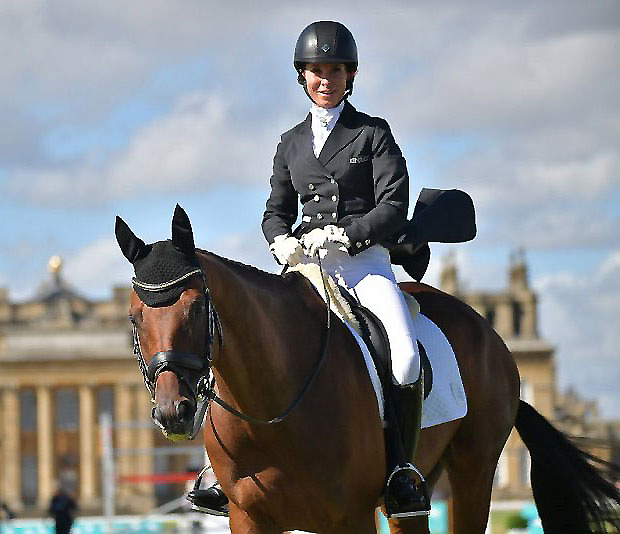
Bettina Hoy is not only one of the top equestrians of modern times, but she really takes her fitness seriously and expects her students to do likewise. You better pay attention to this lady because she knows what she’s talking about.
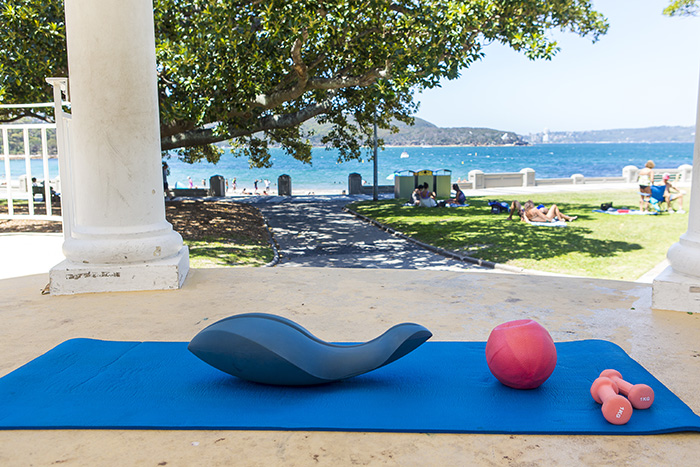
Here it is, Rebecca’s favourite, the Oov – and if you want to see more on how it works before Rebecca and Bettina start work: https://www.youtube.com/watch?v=77ydk4li2G8
The Oov is a tool I’ve been using for about 18 months and I totally love it. It is a perfect form of sport-based training for riders and I also use it in conjunction with other pilates equipment to really up the ante. It has three curves (like the back) which shape both longitudinally and laterally to create support of the spine as well as instability, with the pelvis able to move in all three planes. When someone lies on it, it compresses to about 50% of its volume then pushes back against the user, causing the body to naturally connect into the core…or else fall off! It is cut away to allow freedom of the scapular, and narrows where the thoracic spine sits to allow good movement. The slight decline from tail-to-top creates good diaphragmatic breathing as the secondary breathing muscles are inaccessible.
I’ve put Bettina on the Oov a couple of times now, and it’s been really great to hone in, and work out some of her issues, so that we can get those parts of her body that are a bit ‘stuck’working with more freedom, and stabilise those areas that have weakened. Bettina was still nursing an injury sustained from a cross-country fall at last year’s Europeans when I last saw her, and it was interesting to see how her body was compensating for this. The Olympian has also had an interesting history with her body, which includes being in a brace as a baby and her natural misalignments causing her to fall on her left side 99% of the time when she comes off a horse. The body holds all this history; all these old injuries, habits, and the way it has been put together. There is so much going on in there, and it’s changing all the time. The source of the problem may well not be where the problem shows up. There are also emotions that have an effect, chemical reactions, attitudes; the list goes on.
next, Rebecca tells us why the Oov is so good
Why is the Oov so good? It puts the body in a position where it changes itself. In that way it is task-based learning, so the body will better reset, and remember the new movement patterns. It integrates these patterns without the need for the mind to be conscious of how the change has taken place. It challenges and improves motor control, stability and endurance with correct alignment. This is slow movement training. Because of its shape and density, it creates rotational instability in the body hence unconscious activation of the core, it allows mobility of the hip joints, which are no longer blocked by the ground, and also scapular mobility. It also puts the body into diaphragmatic breathing as the axillary breathing muscles are no longer accessible. Good diaphragmatic breathing affects almost every system in the body, including the nervous system, so it also helps put you in a parasympathetic state, good for keeping a level head while you ride. You should also know, I’m not on Oov’s payroll, I just love them!
Creating stability from instability not only replicates movement from the horses you ride, but helps the body avoid incorrect loading on joints and improves their ability to absorb both the horse’s and rider’s movement through correct functioning, which in turn decreases discomfort and even injury in both horse and rider.
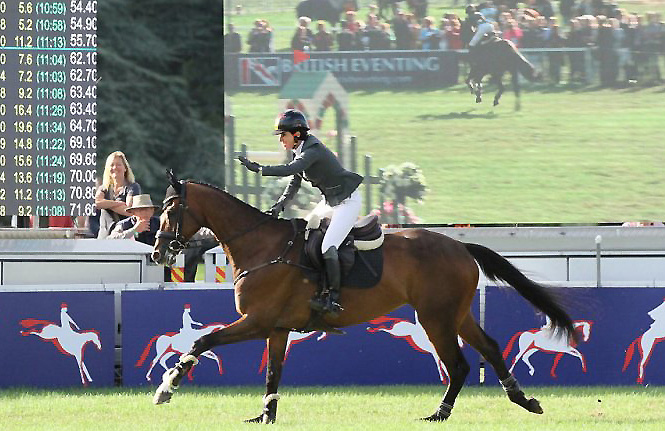
Riding requires quick reactions. In this situation, the body will use what it knows, also known as feed forward control. The body will react to the information it’s getting from the horse’s body. The Oov allows us to teach the body new ways of moving as it feeds information back to the body. When we can react efficiently in more controlled situations, we can add more complex movement patterns and eventually the very complex activity of riding a horse!
Rigidity strategies resulting from habits and injury can unconsciously organise the body in a less-than-efficient way, so we can use the Oov to even things out again, so to speak. When muscles are too rigid or overactive, it’s very hard to balance. Instead we need them to constantly adjust. The best way to balance is to relax (a little bit, anyway!) Relaxation doesn’t mean collapsing in a puddle on the ground, it’s about the body knowing what it must do under the present conditions to remain aligned and functional.
Balance, both physical and mental, needs to be optimal before more functional movement patterns are introduced to the body. The Oov can show if this is in place, or if a person is finding balance through rigidity strategies.
I took Bettina through a long programme, firstly because it was helpful, but mainly because it was fun to see her body reacting to the different information we were feeding it. Here’s a sample of some exercises that I ran through with Bettina.
First of all I stood her up with an Oov between her and the wall. With arms out to the front, I got her to lift one leg at a time, like a slow march, to see what her body was doing; how she was loading her legs or rotating her torso. I then got her to lie with her back on the Oov, the Oov on the ground with legs in ‘table top’(thighs perpendicular to the ground, lower leg parallel to the ground) and arms straight up to the sky. This was to test her balance further. These two tests gave me information on where to start with her exercises.
I really wanted to take a better look at the shoulders, so I got Bettina to put both feet on the ground, hip width apart, knees bent and arms to the sky with a 3kg weight between her hands. I tied a theraband around her legs to give her some lateral stability.
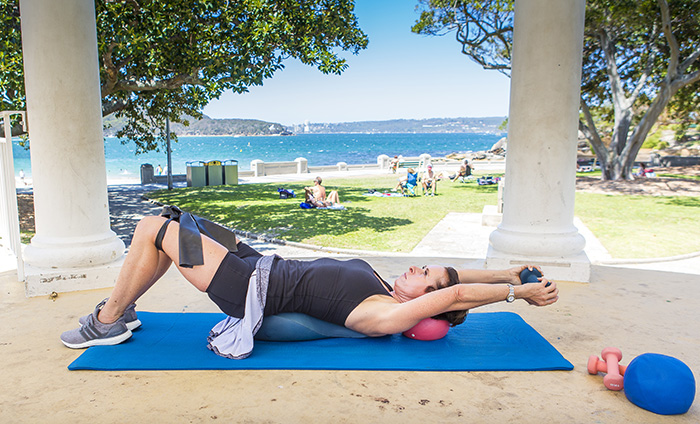
Bettina moved her arms slowly over her head towards the ground, pausing just above the ground for a couple of breaths before returning the arms to the start position, very slowly. This is a lovely exercise to get people breathing correctly and deep from the diaphragm and releasing the shoulders. It encourages the trapezius to relax and the serratus anterior to engage. As well as rearranging the shoulders, this posture really helps calm the client and get them focused inwards into ‘flow state’.
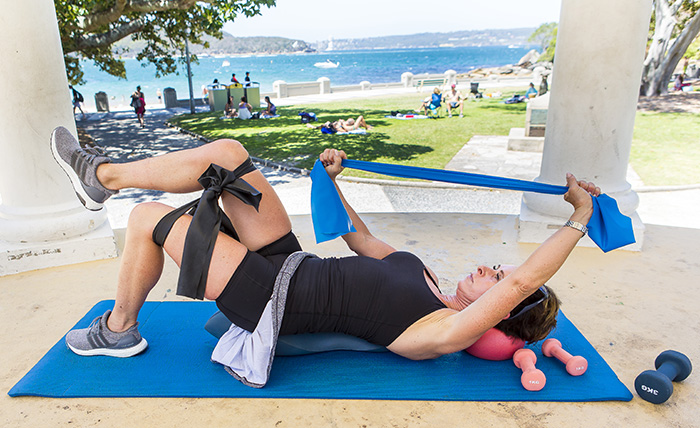
We continued in the supine position with her feet on the ground, knees bent and lifting one leg up into table top at a time. Once we began adding movement, we could see the tendencies of the body better. If Bettina braced her body too much, she lost her balance. The body had to learn dynamic stability. The right leg was harder to move so I added more therabands to give her body information, one already around her legs and one between her hands. Then she lifted the legs at a ration of 4:1, right to left. If you work an asymmetric body symmetrically, you’re not going to get symmetry! Her body preferred, and got more benefit, when she held the band from the right hip to left shoulder as she lifted the right leg (see photo). It sounds complicated, but I want you to see how we can make big, if subtle, changes with the correct information being given to the body. Doing things this way, it’s really the body working things out for itself and this task based learning leads to quicker and more permanent change.
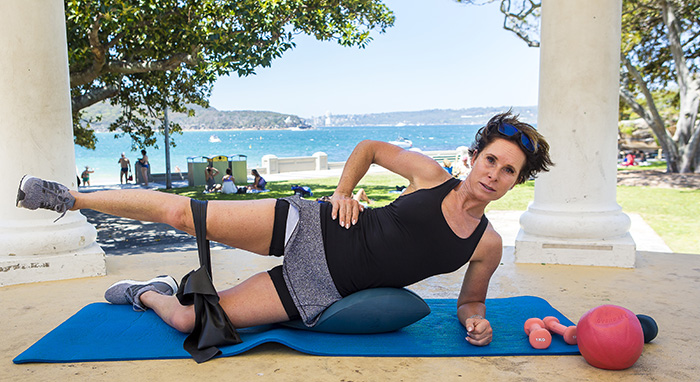
I wanted Bettina to try side-lying legs, as I find this exercise beneficial for riders to create good hip function and femoral glide as a result of seating the femoral head. I kept the band tied around her legs to give her body information laterally, and the instability of the Oov diminished bad habits and rigidity strategies that her body relied on. Bettina laid sideways on the Oov, her lower hip in the seat and her ribs along the big curve, lower leg bent and top leg straight. Lifting her top leg to hip height, I wanted her to swing her leg forward and back as far as she comfortably could, slowly and with control.
This showed me where her leg was more comfortable – forward or back – so I knew where to start the next exercise. Bettina found things easier with her leg back, but she was using her back more than the front of her body for support, so I wanted to guide her into more evenness. I got her to lift her straight top leg up and down in front of her midline, as I stood behind her with a band. She pulled the band forward with her top arm and the resistance from the band helped her close and connect the front of her body. It was harder for her to lift her left leg than her right in this side lying position, but through guidance, the body found a way of working that was more efficient and easier.
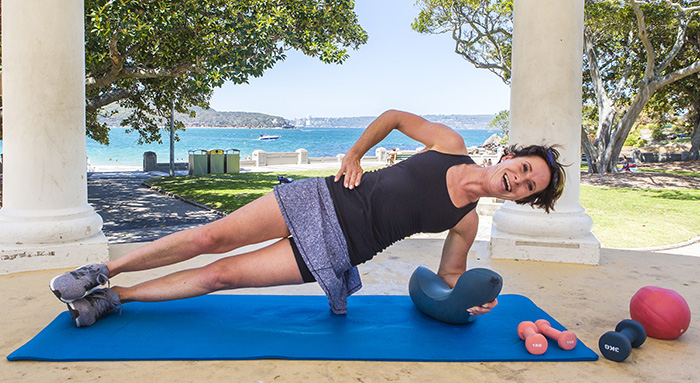
Side plank helped Bettina laterally connect her body as well as working on correct shoulder stability, important with the issues she has. It’s a great deal more challenging than side plank on the ground, because of the unstable surface which requires the body to continuously correct, just like muscles have to do while riding. Lateral work on the Oov is also good for riders who collapse or favour one side their body. This exercise is a great way to engage serratus anterior and lats.
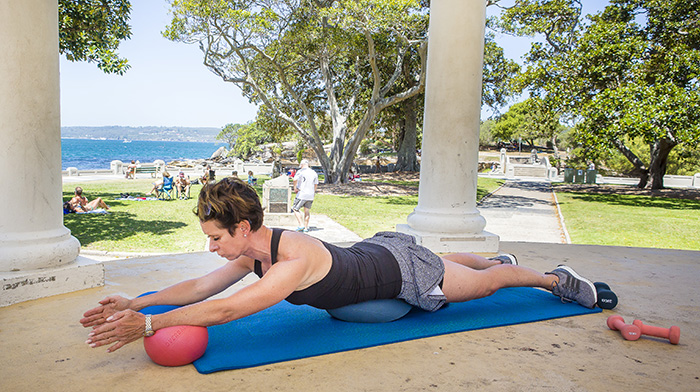
Bettina has a very strong back, so I wanted to make sure it remained mobile and not just locked. I turned the Oov over so she could lie on top of it in prone and focus on moving her thoracic spine. The Oov supports the lumber spine so the mid back is isolated discouraging the body from ‘cheating’by going to places other than the mid-back for mobility. I got Bettina to take her arms out in front of her and place her hands on two pilates balls like she was karate choppingthem. I wanted her to pull the balls towards her with straight elbows, and slide her shoulder blades down her back before continuing the movement through her body to engage the shoulder girdle, as she slowly extended the back. It was important to feel length through the spine and to also keep the pelvis anchored into the Oov so she didn’t just hinge in the thoracolumbar junction.
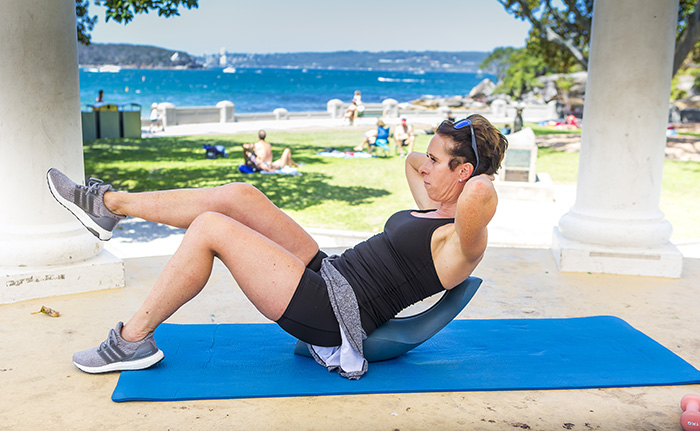
Perched abs was the final exercise I gave Bettina to help her really connect up through her anterior chain, and to help flexion control of the thoracic spine. I sat her close to the ground on the wide part of the Oov and had her curl the spine back until she felt stable. In this position her lumber spine was well supported in a neutral position. This also allowed her hip flexors to move her leg, rather than support and do the work of the core. Her arms reached forward for stability but if I wanted to be horrible, I would have made her put her hands behind her head so her abs would have to work extra hard! Bettina lifted one foot off the ground at a time from the hip, rather than from the knee. Doing this on the unstable surface meant the anterior chain had to work very hard to stabilise, which helped to even out her body between back and front. She was also challenged laterally as she had to remain in control along her sides when lifting one leg at a time so her ribs didn’t poke in the opposite direction.
Bettina summarises the need for off horse fitness, which the German Olympian undertakes everyday, “You are doing so much movement. For example, there were three weeks last year that I hadn’t sat on Designer, but I had done all my exercises everyday (Bettina likes to do a Crossfit programme). Normally after that sort of time off, it would take me about 15 attempts for the half halt to come through correctly when I start off, but the second one came through. I was engaging, I was stronger physically, I was just in a better position.”
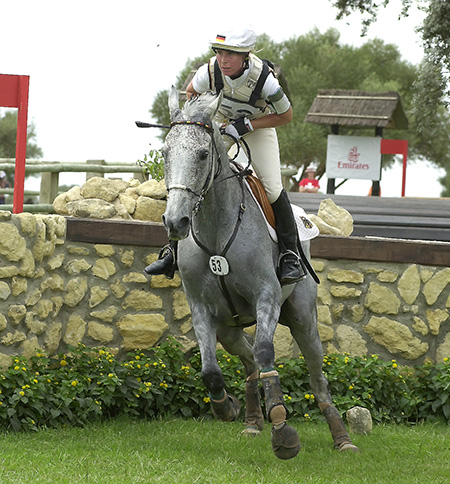
“I also believe the stronger you are in your core when you need it, the safer the sport is. You have a lot of galloping housewives that are so unfit and they just say, “But I’m only hacking out.”Another thing that happens, like in Germany, they buy themselves five-year-olds and all they’re doing is riding in the indoor arena, because they’re too nervous to ride around the field, because if the horse spooks they fall off. By doing weights, which is power as well as fitness, if you imagine the horse spinning quickly, you’re prepared to counteract it, and you don’t fall off. It makes riding for the amateur much safer, and for the serious rider that hasn’t got the physical strength that some guys have….”
“I get tired on Designer, I get tired in the last two minutes of cross country because he just pulls. If I have a difficult combination, and I want to assist him, I have to have that physical strength to tell him to wait and jump a certain line, but also be able to stay in balance because my balance effects the balance of the horse, and helps makes the ride safer. Chris (Bartle) always says, if something goes wrong, you need to be able to go into the ‘oh shit’position. To get into the ‘oh shit’position, you have to be strong in the core or you don’t get there.”
You’ve read the article, now try it for yourself.
Rebecca Ashton is an accredited dressage coach, qualified pilates instructor and qualified Oov practitioner. Find out what the Oov is and how it can transform your riding.
Do you have unevenness in your body? Don’t know where it originates from? Feel that your body doesn’t work as effectively or efficiently as it could but not sure exactly how it’s letting you down?
The Oov provides complex information to the body and brain. It mimics the body and creates a state of instability in order to give the user feedback to enhance the ability to perform more efficient movement; stability from instability, if you will. Using the Oov with weights, therabands and other pieces of equipment gives the body the information it needs to make correct and lasting changes.
If you’re interested in riding better, contact Rebecca on: 0413 787 607 or email: info@equestelite.com



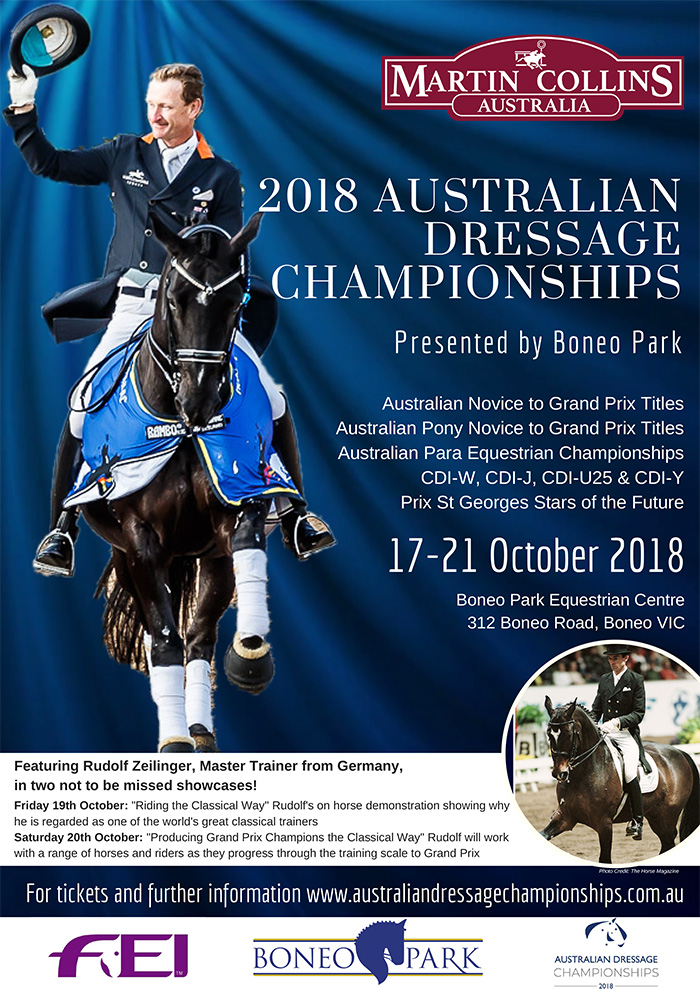

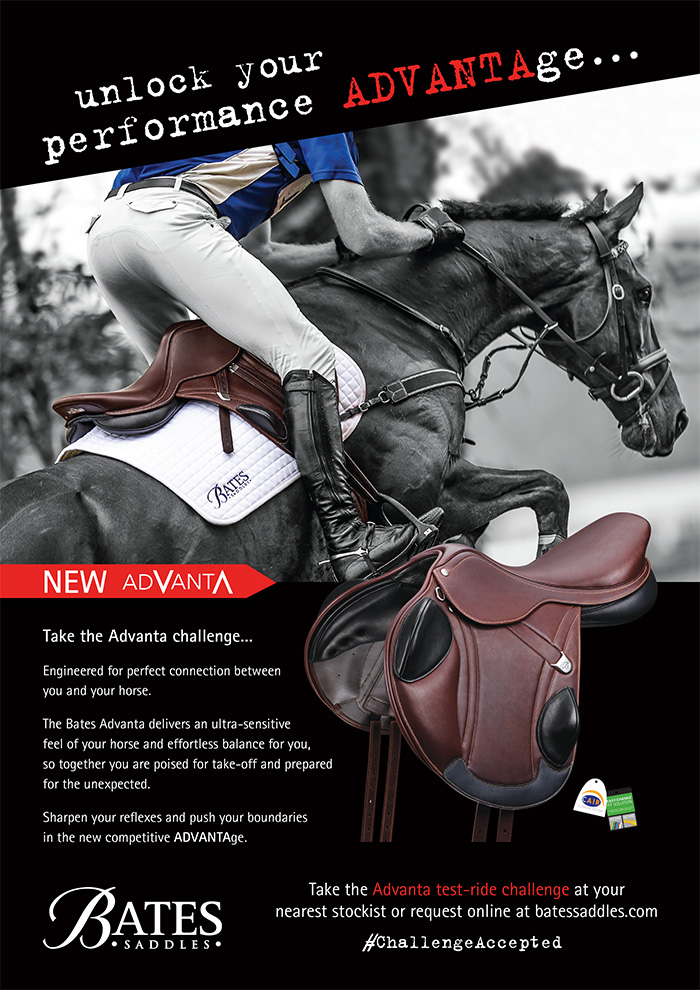
It’s Fantastic to see strength and fitness for rider’s is now becoming more recognised as an important aspects for a rider’s training! Eque-Fitt Australia is booked in to participate in the level I course in the near future, excited for something new 🙂